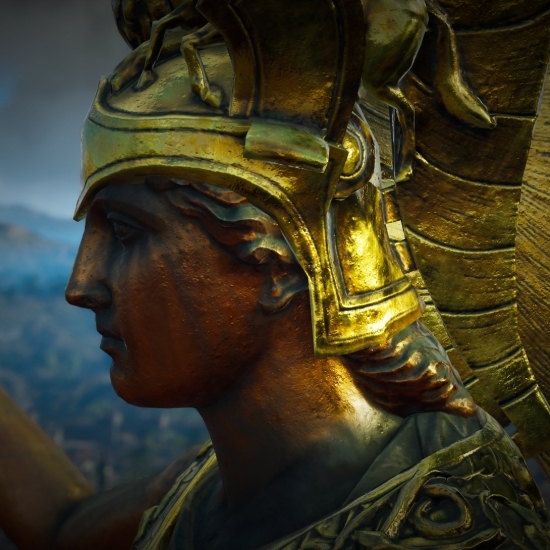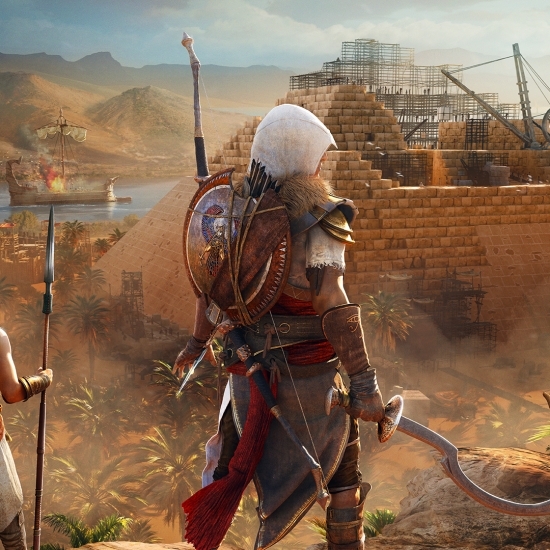INTRODUCTION
With the franchise’s major overhaul in Origins, Assassin’s Creed saw a spike in popularity, along with critical and commercial success, praising its change of style, gameplay, world and new elements. However, that wasn’t without dividing the core fan base from the general public and newcomers to the franchise, with core fans preferring the older style of a more Assassin-focused story and gameplay and a meaningful over-arching narrative progress with a rewarding pay-off.
Now we move forward into Valhalla, the game that is majorly marketed as a Viking fantasy in the Assassin’s Creed universe and a good capper to lingering plot lines. In this spoiler-free review, I’m going to explore the different aspects of game, refraining as much as possible from spoilers, character names and conflicts while emphasizing on the general outline and structure of the narrative and the value of the lore within it, along with a detailed look at gameplay, world and atmosphere.
WORLD
Set mainly in England and Norway with a relatively short time in Vinland, Valhalla introduces one of the biggest if not the biggest and most diverse world in the franchise to date. Similarly to Origins and Odyssey, the world opens up quite early in the game, and is laid across massive areas, both in scale and distance and structured in a way to motivate players to explore and feel the sense of traveling from one place to another.
Eivor explores a good chunk of Norway including the costal areas and the water bodies connecting them, nearby villages and towns, mountains and waterfalls. From a distance, it may seem like an endless monotonous snow desert, but as Eivor explores, you begin to discover the various wonders of the world which, while simpler than the Roman and Saxon structures of England, they’re beautifully crafted with great variety and vibrant colors, plus the natural wonders such as mountains that feel incredibly tall and the beautiful waterfalls flowing off of them.
As we set out to England, the landscape changes drastically and so does the variety of scenery from one place to another. The four kingdoms of England; Mercia, Northumbria, East Anglia and Wessex are uniquely crafted to stand out from each other, in respect to historical and geographical context. There’s a wide variety in the types of structures and architectures that Eivor explores, from inhabited Saxon castles to rundown and abandoned towers and city walls to Roman ruins which are prominent in many parts of the world, especially the City of Lunden, or the wattle and daub homes and lush villages, Norse longhouses in Viking-inhabited areas, the endless green hills of Wessex and the snow-covered Northumbrian lands, all of which are crafted in a beautifully-detailed Tolkienesque style.
One of the best aspects of the world of Valhalla isn’t only its size and diversity, but also how it varies between crowded areas and negative space, both of which have their own beauty and magic. Negative space, whether it’s natural wonders or uninhabited structures forms a large portion of the world and it is crafted in a way that absorbs players into it, creating a lived-in experience with the sense of eagerness to find what old abandoned castle or tower lies in the distance or the seemingly endless plains, mountains and forests.
As for urban crowded spaces, those are crafted with the traditional Assassin’s Creed experience in mind, with tall and short structures more closely erected and connected to one another by ropes and hanging tents, castles and towers with protruding beams, ledges and run down walls, all laid out carefully to encourage a more traditional parkour system, as the game reintroduces a more advanced traversal system from its two most recent predecessors, making the best use of the structures to encourage a more seamless continuous free-running experience, and to spend more time on rooftops and traverse with ease, compared to Origins and Odyssey.
With the surface explored, there’s so much to see hidden underground as many caves, caverns and extensive underground areas are hidden across the world, both in Norway and England, and there’s so much to see that is hidden in plain sight whether in the large negative spaces or the most crowded environment, all contributing to encouraging the sense of exploration.
GAMEPLAY
PROGRESSION
When it comes to gameplay, Assassin’s Creed Valhalla further develops and transforms the RPG system introduced in Origins and expanded in Odyssey. The leveling system is replaced with skill and power, which is tackled through an expansive growth diagram akin to the Sphere Grid in Final Fantasy X and players can choose to expand in different directions emphasizing on different play styles, utilizing the skill points which they receive after each task/quest to evolve. The skill grid is designed like connected constellations starting from one point and evolving in three color-coded directions, one emphasizing on stealth, one on brutal combat and the other on ranged attacks, all of which converge and connect to one another as players expand through them.
Each new step in the grid costs 1 skill point and with each point spent, the power level increases by 1 point. The system is fairly easy to grasp and also isn’t very time consuming to evolve through, as skill points are given in abundance and there’s no shortage of activities around the world, which makes the growth process far less grindy and level-gated
CUSTOMIZATION
Not only can you customize gear and weapons, Eivor can be either male or female, and players can also allow the Animus to variate between the two, switching between male and female at specific moments in the experience. In addition to that, Eivor change their hair/beard into different colors, lengths and styles, apply different type of tattoos, customize their own longship and create their very own Jomsviking raider, in terms of looks and gear, and they will join you on your raids.
Eivor can also customize their gear which is divided into eight pieces, cloak, head, armor, boots, arms and three weapons (one in each hand, and one bow). Valhalla tackles customizations in a different manner from Odyssey and Origins. Instead of having an abundance of recolored versions of the same 2-4 design presets, gear is far more unique and scarce and can be found by pieces around the world during raids or solo exploration. There are no shops around the world selling weapons and armor. There’s only one blacksmith who lives in the settlement and they help upgrading existing weapons and gear with your resources, which will also change their design. Every weapon and gear piece can be upgraded into 4 levels and there are resources required in order for the blacksmith to upgrade them, and within each level there are side upgrades which Eivor can upgrade anytime anywhere if the right resources were present, however the design can only change when the piece of gear is evolved by the blacksmith from one major level to another.
The Tattooist also lives only in the settlement and the only merchants around the worlds are those that sell some resources like iron, leather, rations, arrows along with cosmetic items like tattoo blueprints, hair and beard designs and settlement cosmetic designs, all of which can be applied when you revisit the settlement.
COMBAT
As a Viking, Eivor engages in a far more weighty and brutal combat. Whether it’s the movement, the weapons swings, the thump and and weight of every action, everything contributes to the brutality of the combat which is the personification of a Viking warrior, and character growth through skills and abilities introduces more adrenaline special attacks, both melee and ranged.
At first, I was a bit frustrated with it, but as I grew to learn it within the first few hours, engaging in combat became far more fun that I’d specifically seek it out for how satisfying and weighty it is.
STEALTH / PARKOUR
Valhalla re-introduces stealth and parkour much more efficiently in Valhalla than its two predecessors. Social stealth is back for the first time since Syndicate, and the structure of the world is specifically designed to encourage a stealthy approach, from bushes to tall grass to hiding in plain sight among a crowd, sitting on a bench or a dinner table with strangers or pretending to partake in a certain activity, waiting for the right moment to execute an attack or avoid detection.
The Hidden Blade returns after its total absence in Odyssey and with the skill system, or the newly introduced “Guaranteed Assassination” feature, you can execute a one hit death blow to almost any type of enemy as long as you’re stealthy. The Hidden Blade cannot be used in open combat, but it is a hugely beneficial instrument that allows you to tackle higher power-level areas with more ease, especially with Guaranteed Assassination on, allowing you to take a fully stealthy approach and taking down enemies one by one.
The game manages to bring two worlds together, for as much there’s brutality in open combat, there are so many elements in the world encouraging subtlety, as everything is designed with stealth and parkour in mind and there’s room and freedom to experience both.
QUESTS
Like its predecessor, Valhalla’s quest system is divided into multiple quest lines and arcs. There are settlement-related quests, England story arcs and mythical world arcs. The settlement is home to different characters, including the Hidden Ones bureau, and therefore, Settlement errands range from building structures and participating in small events to major story quests.
The major quest line however is based around pacifying England. As Eivor sets foot in the Ravensthorpe settlement, the first standing structure is the Longhouse, where Randvi is in charge the battle table from which Eivor can pledge to a certain story arc per region. You can abandon the quest line at any time and pursue other activities.
Every quest line begins and ends in the settlement either by finishing the entire quest within it or venturing out into the world and returning with news, resources or a new ally and resident in the settlement and opportunities for more, and the quest stricture itself is crafted like an episodic anthology tv show, especially the England pacification arcs, each of which takes from 1-3 hours to finish and each quest and arc is created to feel meaningful and none of the quests is marked as “main” and “side” quests, but rather all of them are crafted in the same attention to detail and scope and all pour into the overall journey narrative-wise, rather than an abundance of repetitive meaningless errands.
WORLD EVENTS
Aside from arcs, there are various world events to tackle from helping out citizens in smaller activities such as carrying someone to safety or finding why one person who went diving after a treasure hasn’t come out yet, to Animus Anomalies where the Animus simulation freezes and Layla enters the world as herself and participates in some elaborate challenging, well-designed platforming puzzles akin to The Lost Archive expansion of Assassin’s Creed Valhalla and the DLC levels of the original Mirror’s Edge, during which cryptic recordings of key figures play, revealing new mysteries and a mind-blowing reward after completing all of them, similarly to The Truth in Assassin’s Creed II.
In addition, Eivor, will stumble upon personal, more puzzle-driven activities such as the Pagan ruins with cryptic messages, underground caverns with platforming puzzles, cairn building, mushroom trips, drinking, flying and dice games, all of which add more reward to exploration and opportunities to gain skills and interact with the world and the people in it, as well as exploring some minute details about Eivor or the overarching narrative.
STORY
Valhalla’s narrative is divided into different arcs: Eivor’s story, Pacifying England, The Hidden Ones, Mythical Realms and the overarching narrative. Unlike Odyssey, there’s a degree of order and succession in how each arc plays out. First we begin with a brief segment of Eivor’s childhood in Norway and then tragedy strikes and we fast-forward in memory to an adult Eivor as they encounter their adoptive father King Styrbjorn, Randvi and shortly afterwards, Sigurd and the Hidden Ones.
While in Norway, the narrative is rather linear, but as we get to England, the story diverges into different arcs. Pacifying England is laid out in forms of a map of the British Isles with each region marked on it that Eivor can freely pledge to and being the respective story of each region. As you conquer more lands, newer regions become available, which can be tackled freely. As Eivor returns to the settlement after finishing an arc, opportunities regarding the other arcs open up, and similarly towards the end, the stories begin to converge and end with a pre-defined succession that makes sense to the overall narrative.
Players will spend a very long time pacifying England, with each region taking around 2-3 hours to complete. While this may seem a excessive, it is a great factor in conveying more meaning and allowing more time to connect with the characters we encounter. Most element in the game are connected, and newly introduced character end up returning and playing larger roles as the story progresses. They are not random NPCs or brief encounters. Everything is either directly related to the main narrative and future quests, connected to Eivor on a personal level, portraying an historical/cultural custom, symbolizing a lore aspect or foreshadowing future outcomes.
When it comes to the lore and the place and meaning of Valhalla within the franchise’s vast overarching narrative, Valhalla is the richest and most meaningful experience lore-wise since Assassin’s Creed III and Black Flag. It is the first game in a long time to directly reference past plot-lines both the ones that started with Origins and lingering ones from the more classic era of Assassin’s Creed, and works to resolve conflicts, expand on obscure areas, bring back familiar faces and introduce new elements and conflicts. And as for the mythical worlds, like every other aspect, it all pools together within the overall narrative. There’s more to it than just a showcase of fantasy world. Technically, it is an excuse to explore the mythology, but there’s a also more meaning to it within the overarching narrative and good reasoning as to how and why it happens.
Assassin’s Creed Valhalla is also a very long slow-burn of an experience with the lore feeling a bit distant from the main Viking and Eivor stories after first being introduced, but once you reaches its culminating phase, everything will start to fall in place and it will throw one mind-blowing twist and grand revelation after another, and it also doesn’t exactly end with pacification of England as there’s far more main narrative placed as optional arcs around the world to explore the complete picture.
PROTAGONIST
Eivor is an intelligent mixture of brutality and compassion, strength and emotional depth. Despite the presence of player choice, Eivor is an established character with a personality, worldview, attitude and backstory of their own. They are not a blank slate for the player to create, there’s an established ground for who they are, how they belong in the story, how and why player choice are possible, and dialogue options can only emphasize on one part of the character over the other, instead of standing out as an out-of-character behavior.
Their journey explores their past, present and their place in the future, developing the character both through pre-established narrative and players’ own choices, that by the end, I couldn’t feel that this is a character I chose, but rather one who is established in a similar light to Geralt of Rivia than Alexios and Kasssandra. I variated between male and female Eivor, and both sides are portrayed beautifully and there’s quite an intriguing premise behind Eivor’s story and a convincing explanation as to why the choice of protagonist is possible. It is more than just “pick your character and the story will follow based on what you picked” and the reasoning is clear, convincing an noticeable throughout the story.
VISUAL FIDELITY
Visually-speaking, the game has evolved drastically compared to the early reveal trailers. From the first glance at the trailers, the game might feel like a re-skin of Odyssey. However, the experience itself has grown far more distinct with its unique set pieces, atmosphere and attention to detail. There’s also great variety in world design and structures, outfits are beautifully detailed and the overall atmosphere changes in different time of day, and the overall look and feel, whether it’s England, Norway, Asgard, Jotunheim or Vinland, have a nice blend of realism, grittiness, vastness, grandiose, fairytale, dreamy and mythical vibes that work quite well for their respective arcs.
The difference in weather along with architecture, geography and colors further aids in making areas stand-out from one another, as places like Lunden (London), Jorvik (York), Wicestre (Winchester), Fornburg, Cent (Kent) and Ravensthorpe (the settlement) each have a unique style and atmosphere that makes their respective arcs almost feel like they comes from different games.
Character models are well-designed and detailed, the rivers separating the landmasses look gorgeous especially as you sail for prolonged periods and witness the change in the time of day, the bridges extending in different styles across them and the different visual print of the lands on both banks.
Most of the game’s beauty stems from the uniqueness in its set pieces, rather than photo-realism. Visually, it is within the range of Odyssey and Origins, but with its variety, it can make locations feel more memorable than Odyssey and it’s closer to Origins in terms of its endless open plains that evoke a desire to discover.
SOUND
With the return of Jesper Kyd and the involvement of Sarah Schachner and Einar Selvik, the music is no less essential than every other aspect in creating the complete beautiful picture of a Viking story. Einar Selvik’s vocals are the most essential aspect of the music, and the overall soundtrack varies between traditional Viking chants and shanties, historical/epic vibes and more modern and ambient themes.
There’s music during exploration that is structured in a way that it isn’t constant and also not completely absent. There are moments of silence where you admire the sounds of the living, breathing world and and gradually an ambient track would start playing, which is a great variation as the sounds of the atmosphere are just as beautiful as the music, and luckily the main theme isn’t another rework of Ezio’s Family, which further helps giving this game an identity of its own.
FINAL WORD
On the surface, Valhalla is very much an open world, fantasy RPG that is far more similar to the likes of The Witcher than its predecessors, further expanding on the genre’s elements, aesthetic and play style making more use of dialogue options, romances, settlement building, character progression and growth through skill and ability trees, upgradable weapons and gear and additional runes to imbue them with more power, the brutal combat, raids and the resources coming from them that is essential for settlement growth, exploration which is very rewarding both in terms of character progression/loot and also both lore, myth, legend and historical events.
Narrative-wise, there’s a lot of time spent in kingdoms and being involved in the politics, the fragile foundations of peace and truces and the hairline between loyalty and responsibility, glory and honor, righteousness and obedience.
And therefore, it is far similar to a classic historical/fantasy RPG in that regard, but as we dig below the skin level of experience, there’s so much that a hardcore Assassin’s Creed fan would rejoice in. There’s an abundance of lore, whether it’s in the form of recounting, continuing or symbolizing plot lines that began with Layla Hassan, the present day protagonist, in Origins or ones that started long before, as well as introducing new elements and shocking surprises, and engaging into the history of the Hidden Ones and The Order of the Ancients, and sowing the seeds for their eventual growth into their more recent names of Assassins and Templars.
Narrative Director Darby McDevitt described the game as a “Viking fantasy in the Assassin’s Creed universe” and he couldn’t be more accurate, and that is not exactly a bad thing as neither aspect undermines the other. Valhalla is the first genuine attempt to bridge the gap between the old narrative arcs and play styles, such as a more advanced parkour and stealth elements and the new RPG approach, and for the first time since Assassin’s Creed III, this game genuinely tries its best to be a sequel, and not another independent story in the universe with vague easter eggs and references. There’s a sense of continuity and a nice conclusion to some lingering plot lines while opening the doors for great new concepts and directions, which I sincerely hope would pick up as strongly as they did in Valhalla, afterwards, and this combination of old and new is a genuine attempt which I hope future games will further build upon, and it makes me lament the fact that both Origins and Odyssey missed out on such balance and exploration of both the history, the science fiction lore, protagonist story and mythology.
Assassin’s Creed Valhalla is not story that shows its clear focus from the opening chapter like the older titles, nor does it tackle the essential lore aspects as easter eggs, but it lays out its concepts here and there and it takes its time developing each of them over tens of hours of playtime in the main narrative arcs alone. It is one experience that needs to be consumed as a whole to completely appreciate its value and place within the grand universe, and it does so phenomenally well.
-
 RINO THE BOUNCERPharmacist. Visual Artist. Ubisoft Star Player, Assassin's Creed Brand Ambassador, Founder and Community Leader of The Codex. Tomb Raider Localization Ambassador and Official Fansite Founder.NEWS FEEDTestimonial"Just stumbled across this site after looking at some topics on the Ubisoft Forums, this is great! Exactly the thing I was looking for.""Your site lays everything down in an interesting and easy to read format, even I learn new things whilst reading your articles!""This needs more than just 5 stars!""There is only one word AMAZING!!!!!!! GREAT WORK.""Very in depth and very well thought out! Keep up the good work!"One of the best (if not the best one) AC community pages out there. Keep up the good work!
RINO THE BOUNCERPharmacist. Visual Artist. Ubisoft Star Player, Assassin's Creed Brand Ambassador, Founder and Community Leader of The Codex. Tomb Raider Localization Ambassador and Official Fansite Founder.NEWS FEEDTestimonial"Just stumbled across this site after looking at some topics on the Ubisoft Forums, this is great! Exactly the thing I was looking for.""Your site lays everything down in an interesting and easy to read format, even I learn new things whilst reading your articles!""This needs more than just 5 stars!""There is only one word AMAZING!!!!!!! GREAT WORK.""Very in depth and very well thought out! Keep up the good work!"One of the best (if not the best one) AC community pages out there. Keep up the good work!





